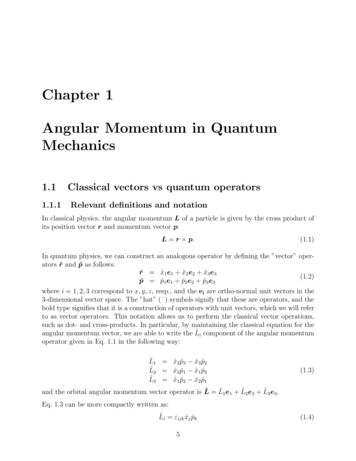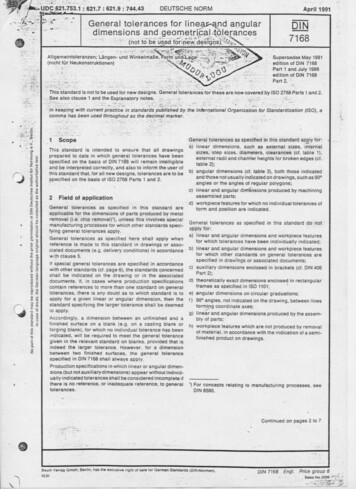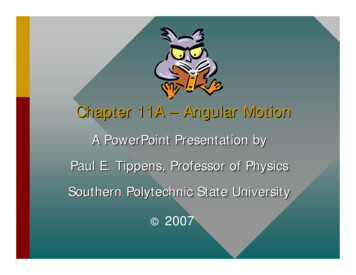
Transcription
16/05/2012Lecture PowerPointsChapter 11Physics for Scientists andEngineers, with ModernPhysics, 4th editionGiancoli 2009 Pearson Education, Inc.This work is protected by United States copyright laws and is provided solely forthe use of instructors in teaching their courses and assessing student learning.Dissemination or sale of any part of this work (including on the World Wide Web)will destroy the integrity of the work and is not permitted. The work and materialsfrom it should never be made available to students except by instructors usingthe accompanying text in their classes. All recipients of this work are expected toabide by these restrictions and to honor the intended pedagogical purposes andthe needs of other instructors who rely on these materials.Copyright 2009 Pearson Education, Inc.Chapter 11Angular Momentum;General RotationCopyright 2009 Pearson Education, Inc.1
16/05/2012Units of Chapter 11 Angular Momentum—Objects Rotating About aFixed Axis Vector Cross Product; Torque as a Vector Angular Momentum of a Particle Angular Momentum and Torque for a System ofParticles; General Motion Angular Momentum and Torque for a RigidObject Conservation of Angular Momentum The Spinning Top and GyroscopeCopyright 2009 Pearson Education, Inc.11-1 Angular Momentum—ObjectsRotating About a Fixed AxisThe rotational analog of linear momentumis angular momentum, L:Then the rotational analog of Newton’ssecond law is:This form of Newton’s second law is valideven if I is not constant.Copyright 2009 Pearson Education, Inc.2
16/05/201211-1 Angular Momentum—ObjectsRotating About a Fixed AxisIn the absence of an external torque,angular momentum is conserved:dL 0 and L I constant.dtMore formally,the total angular momentum of arotating object remains constant if thenet external torque acting on it is zero.Copyright 2009 Pearson Education, Inc.11-1 Angular Momentum—ObjectsRotating About a Fixed AxisThis means:Therefore, if an object’s moment of inertiachanges, its angular speed changes as well.Copyright 2009 Pearson Education, Inc.3
16/05/201211-1 Angular Momentum—Objects RotatingAbout a Fixed AxisA skater doing a spin on ice, illustrating conservation ofangular momentum: (a) I is large and ω is small; (b) I issmaller so ω is larger.A diver rotates faster when arms and legs are tucked inthan when they are outstretched.Copyright 2009 Pearson Education, Inc.Conservation of Angular MomentumClick on frame to show videoCopyright 2009 Pearson Education, Inc.4
16/05/201211-1 Angular Momentum—ObjectsRotating About a Fixed AxisExample 11-1: Object rotating on a string of changinglength.A small mass m attached to the end of a string revolves in acircle on a frictionless tabletop. The other end of the stringpasses through a hole in the table. Initially, the massrevolves with a speed v1 2.4 m/s in a circle of radiusR1 0.80 m. The string is then pulled slowly through thehole so that the radius is reduced to R2 0.48 m. What isthe speed, v2, of the mass now?Copyright 2009 Pearson Education, Inc.11-1 Angular Momentum—Objects RotatingAbout a Fixed AxisFor small mass: I mr2Conservation of Angular Momentum: I I0 0 mr 2 mr02 0 r 2 r02 0& v r r 2 v r02 v0 rr0 v2 v vr rv r0 v0v0 v1 2.4 m/sv v2r0 R1 0.80 mr R2 0.48 mr0 v0 0.80 2.4 4.0 m/sr0.48Copyright 2009 Pearson Education, Inc.5
16/05/201211-1 Angular Momentum—ObjectsRotating About a Fixed AxisExample 11-2: Clutch.A simple clutch consists of two cylindrical platesthat can be pressed together to connect twosections of an axle, as needed, in a piece ofmachinery. The two plates have masses MA 6.0 kgand MB 9.0 kg, with equal radii R0 0.60 m. Theyare initially separated. Plate MA is accelerated fromrest to an angular velocity ω1 7.2 rad/s in timeΔt 2.0 s. Calculate (c) Next, plate MB, initially at restbut free to rotate without friction, is placed in firmcontact with freely rotating plate MA, and the twoplates both rotate at a constant angular velocity ω2,which is considerably less than ω1. Why does thishappen, and what is ω2?Copyright 2009 Pearson Education, Inc.11-1 Angular Momentum—ObjectsRotating About a Fixed AxisExample 11-2: Clutch.A simple clutch consists of two cylindrical platesthat can be pressed together to connect twosections of an axle, as needed, in a piece ofmachinery. The two plates have masses MA 6.0 kgand MB 9.0 kg, with equal radii R0 0.60 m. Theyare initially separated. Plate MA is accelerated fromrest to an angular velocity ω1 7.2 rad/s in timeΔt 2.0 s. Calculate (a) the angular momentum of MAL I 6.0 0.6 2IA M A R 1.08 kg.m 22 L I 1.08 7.2 7.8 kg.m 2 /s122ACopyright 2009 Pearson Education, Inc.6
16/05/201211-1 Angular Momentum—ObjectsRotating About a Fixed AxisExample 11-2: Clutch.A simple clutch consists of two cylindrical platesthat can be pressed together to connect twosections of an axle, as needed, in a piece ofmachinery. The two plates have masses MA 6.0 kgand MB 9.0 kg, with equal radii R0 0.60 m. Theyare initially separated. Plate MA is accelerated fromrest to an angular velocity ω1 7.2 rad/s in timeΔt 2.0 s. Calculate (b) the torque required to haveaccelerated MA from rest to ω1 I & 0 t 0 7.2 0 3.60 rad/s 22.0 t I 7.8 3.60 3.9 N.mCopyright 2009 Pearson Education, Inc.11-1 Angular Momentum—ObjectsRotating About a Fixed AxisExample 11-2: Clutch.Calculate (c) plate MB, initially at rest but free torotate without friction, is placed in firm contact withfreely rotating plate MA, and the two plates bothrotate at a constant angular velocity ω2, which isconsiderably less than ω1. Why does this happen,and what is ω2?Angular momentum is conserved(this is a rotational collision)6.0 0.6 2 1.08 kg.m 229.0 0.6 2I B 12 M B RB2 1.62 kg.m 22I A A I A I B BI A 12 M A RA2 B I A A1.08 7.2 2.9 rad/sI A I B 1.08 1.62Copyright 2009 Pearson Education, Inc.7
16/05/201211-1 Angular Momentum—ObjectsRotating About a Fixed AxisExample 11-3: Neutron star.Astronomers detect stars that are rotating extremelyrapidly, known as neutron stars. A neutron star isbelieved to form from the inner core of a larger starthat collapsed, under its own gravitation, to a star ofvery small radius and very high density. Beforecollapse, suppose the core of such a star is the size ofour Sun (r 7 x 105 km) with mass 2.0 times as great asthe Sun, and is rotating at a frequency of 1.0 revolutionevery 100 days. If it were to undergo gravitationalcollapse to a neutron star of radius 10 km, what wouldits rotation frequency be? Assume the star is a uniformsphere at all times, and loses no mass.Copyright 2009 Pearson Education, Inc.11-1 Angular Momentum—ObjectsRotating About a Fixed AxisExample 11-3: Neutron star.r0 7 105 km 0 1 rev/100 days1 1.16 10 7 rev/s100 24 3600r 10 km I I 0 0I 0 0 52 mr02 r 2 2 0 0 0I r 5 mr 22 7 105 1.16 10 7 568 600 rev/s 10 Copyright 2009 Pearson Education, Inc.8
16/05/201211-1 Angular Momentum—ObjectsRotating About a Fixed AxisAngular momentum is avector; for a symmetricalobject rotating about asymmetry axis it is in thesame direction as theangular velocity vector.Angular momentum points along the axisof rotation in a direction given by the righthand rule. – Fingers curl in the direction ofrotation – Thumb points in direction ofangular momentum vectorCopyright 2009 Pearson Education, Inc.11-1 Angular Momentum—ObjectsRotating About a Fixed AxisExample 11-4: Running on a circular platform.Suppose a 60 kg person stands at the edge ofa 6.0 m diameter circular platform, which ismounted on frictionless bearings and has amoment of inertia of 1800 kg·m2. The platformis at rest initially, but when the person beginsrunning at a speed of 4.2 m/s (with respect tothe Earth) around its edge, the platformbegins to rotate in the opposite direction.Calculate the angular velocity of the platform.Copyright 2009 Pearson Education, Inc.9
16/05/2012Example 11-4: Running on a circular platform.v r v / rm 60 kgr 3.0 mv 4.2 m/sI person mr 2I platform 1800 kg.m 2Lperson I person mr 2 (v / r ) mrvConservation of Angular Momentum Total L is zeroL Lperson Lplatform0 mrv I platform mrvI platform 60 3.0 0.42 0.42 rad/s1800Note : 2 f 2 / T T 2 / 15 s per revolutionCopyright 2009 Pearson Education, Inc.11-1 Angular Momentum—ObjectsRotating About a Fixed AxisConceptual Example 11-5:Spinning bicycle wheel.Your physics teacher is holdinga spinning bicycle wheel whilehe stands on a stationaryfrictionless turntable. What willhappen if the teacher suddenlyflips the bicycle wheel over sothat it is spinning in theopposite direction?Copyright 2009 Pearson Education, Inc.10
16/05/2012Conceptual Example 11-5: Spinning bicycle wheel.Angular momentum isconserved, so the person willstart spinning in the directionthe wheel was spinningoriginally.Clickimageto playvideoCopyright 2009 Pearson Education, Inc.Initially, we haveLsystem L0 (upward)After the wheel is inverted,Lsystem L0 Lperson turntable LwheelIn this case Lwheel -L0(rotating in opposite direction) L0 Lperson turntable – L0 Lperson turntable 2L0This shows that the person and turntablewill rotate in the same direction as theoriginal direction of the wheel and withan angular momentum equal to twice theinitial angular momentum of the wheel.Copyright 2009 Pearson Education, Inc.11
16/05/201211-2 Vector Cross Product; Torque as aVectorThe vector cross product is defined as:The direction of the cross product isdefined by a right-hand rule:Copyright 2009 Pearson Education, Inc.11-2 Vector Cross Product; Torque as aVectorThe cross product can also be written indeterminant form:Copyright 2009 Pearson Education, Inc.12
16/05/201211-2 Vector Cross Product; Torque as aVectorSome properties of the cross product:Copyright 2009 Pearson Education, Inc.11-2 Vector Cross Product; Torque as aVectorTorque can be defined as the vectorproduct of the force and the vector fromthe point of action of the force to the axisof rotation:Using the right hand ruleshows that the torquevector points along theaxis of rotation and is outof the page.Copyright 2009 Pearson Education, Inc.13
16/05/201211-2 Vector Cross Product; Torque as aVectorFor a particle, the torque can be definedaround a point O: Here, r is the position vector from theparticle relative to O.Copyright 2009 Pearson Education, Inc.Example 11-6: Torque vector. Suppose the vector r is in the xz plane, and isgiven by r (1.2 1.2 m) Calculate the m)torque vector if F (150 N) . τ r F 1.2 ˆi 1.2 kˆ 150 ˆi 180 ˆj N.m ie. τ is in y directionNote : ˆi ˆi 0kˆ ˆi ˆjCopyright 2009 Pearson Education, Inc.14
16/05/201211-3 Angular Momentum of a ParticleThe angular momentum of a particle abouta specified axis is given by:Copyright 2009 Pearson Education, Inc.11-3 Angular Momentum of a Particle If we take the derivative of L , we find:Sincewe have:This is the rotational analogue of Newton’s 2nd LawCopyright 2009 Pearson Education, Inc.15
16/05/201211-3 Angular Momentum of a ParticleConceptual Example 11-7: A particle’sangular momentum.What is the angular momentum of aparticle of mass m moving with speed v ina circle of radius r in a counterclockwisedirection? L r p r mv L is directed outwards perpendicular to both r and v (RH Rule)L rmv sin 90 rm.r mr 2 I Copyright 2009 Pearson Education, Inc.11-4 Angular Momentum and Torque fora System of Particles; General MotionThe angular momentum of a system ofparticles can change only if there is anexternal torque—torques due to internalforces cancel.This equation is valid in any inertialreference frame. It is also valid for thecenter of mass, even if it is accelerating:Copyright 2009 Pearson Education, Inc.16
16/05/201211-5 Angular Momentum and Torque fora Rigid ObjectFor a rigid object, we can show that itsangular momentum when rotatingaround a particular axis is given by:Copyright 2009 Pearson Education, Inc.11-5 Angular Momentum and Torque fora Rigid ObjectExample 11-8: Atwood’s machine.An Atwood machine consists of twomasses, mA and mB, which areconnected by an inelastic cord ofnegligible mass that passes over apulley. If the pulley has radius R0 andmoment of inertia I about its axle,determine the acceleration of themasses mA and mB, and compare tothe situation where the moment ofinertia of the pulley is ignored.Copyright 2009 Pearson Education, Inc.17
16/05/2012The angular momentum about O isL Lpulley LmA LmB I R0 mA v R0 mBvExample 11-8:Atwood’s machine.Also v/R 0L mA mB vR0 IvR0The external torque about O is mB gR0 - m A gR0 ( taking clockwise as ve) dLdt m B mA gR0 mA mB R0 dv a m B mA gdv dt mA mB I R02dtI dvR0 dtCopyright 2009 Pearson Education, Inc.a m B mA gdv dt mA mB I R02Example 11-8:Atwood’s machine.If the moment of inertia of the pulleyis ignored we geta dv m B mA g dt mA mB Which is the same result as for the idealacceleration in experiment E1 Mechanicsand Forces where the effect of the pulleywas ignored (pulley assumed to havenegligible mass).The effect of the moment of inertia of thepulley is to slow down the system.Copyright 2009 Pearson Education, Inc.18
16/05/201211-5 Angular Momentum and Torque fora Rigid ObjectConceptual Example 11-9: Bicyclewheel.Suppose you are holding a bicyclewheel by a handle connected to itsaxle. The wheel is spinning rapidlyso its angular momentum pointshorizontally as shown. Now yousuddenly try to tilt the axle upward(so the CM moves vertically). Youexpect the wheel to go up (and itwould if it weren’t rotating), but itunexpectedly swerves to the right!Explain.Copyright 2009 Pearson Education, Inc.Conceptual E
11-1 Angular Momentum—Objects Rotating About a Fixed Axis Example 11-3: Neutron star. 1.16 10 568 600 rev/s 10 7 10 7 5 2 0 2 0 2 0 5 2 2 5 0 2 0 0 0 0 r r mr mr I I I I 10 km 1.16 10 rev/s 100 24 3600 1 1 rev/100 days 7 10 km 7 0 5 0











